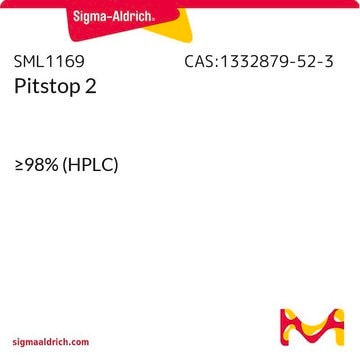Yes, this material has a fluorescence spectrum similar to DAPI, with excitation at 340-380 nm and emission at 385-470 nm. The images displayed above were acquired using UV filter set (340-380 nm excitation, 40 nm dichroic, 430-nm long pass filter). Please note that Filipin fluorescent staining photo-bleaches very rapidly, thus the sample should be analyzed immediately.
SAE0087
Filipin III ready made solution
from Streptomyces filipinensis, 1mg/ml in DMSO based solution
Sinónimos:
Filipin III solution
Seleccione un Tamaño
296,00 €
Seleccione un Tamaño
About This Item
296,00 €
Productos recomendados
Nivel de calidad
Ensayo
≥95% (HPLC)
Formulario
ready-to-use solution
condiciones de almacenamiento
protect from light
Condiciones de envío
dry ice
temp. de almacenamiento
−20°C
Categorías relacionadas
Descripción general
used as a probe for sterol location in biological membranes 2 and has been used clinically as a stain for free cholesterol in the study of Type C Niemann-Pick disease. 3 Filipin inhibits prion protein (PrP) endocytosis and causes the release of PrP from the plasma membrane. 4 Filipin III was found to trigger signaling responses in tobacco cells, including a NADPH oxidase-dependent production. 5. The antifungal mechanism of action may be due to altering membrane permeability and associated functions by binding to membrane sterols. Filipin inhibits prion protein (PrP) endocytosis and causes the release of PrP from the plasma membrane.
Aplicación
Otras notas
- Filipin III solution is very sensitive to air and light. Upon receipt aliquot and store at -20°C avoid freeze thaw cycles.
- Filipin III is used in various concentrations depending on the specific protocol used. Dilute 1mg/ml stock solution with appropriate buffer according to the used protocol.
- Filipin III interaction with cholesterol alters the absorption and fluorescence spectra, for visualization with a fluorescence microscope use excitation at 340-380 nm and emission at 385-470 nm (Filipin fluorescent staining photo-bleaches very rapidly, thus the sample should be analyzed immediately).
Código de clase de almacenamiento
10 - Combustible liquids
Clase de riesgo para el agua (WGK)
WGK 1
Punto de inflamabilidad (°F)
188.6 °F
Punto de inflamabilidad (°C)
87 °C
Elija entre una de las versiones más recientes:
Certificados de análisis (COA)
¿No ve la versión correcta?
Si necesita una versión concreta, puede buscar un certificado específico por el número de lote.
¿Ya tiene este producto?
Encuentre la documentación para los productos que ha comprado recientemente en la Biblioteca de documentos.
Los clientes también vieron
-
Would it be possible to image this product using a DAPI filter (Excitation 377 nm, Emission 447 nm)?
1 respuesta-
¿Le ha resultado útil?
-
-
Any suggestions for addressing white precipitations observed during Filipin staining for endothelial cells, possibly due to DMSO? Also, seeking advice to improve the experiment where most cells were negative for Filipin staining, and only a few were positive while measuring cholesterol content in HUVEC cells.
1 respuesta-
To address white precipitations observed during Filipin staining for endothelial cells, increasing the amount of DMSO in the final staining solution may be necessary. This can be achieved by diluting the 1 mg/ml Filipin III solution with more DMSO solution to create a 0.5 mg/ml or 0.1 mg/ml concentrated solution prior to staining the samples.
For improving cholesterol content measurement in HUVEC cells, optimize the working concentration of Filipin and conduct a time-course experiment to enhance staining results. Prompt analysis of stained samples can help prevent photobleaching.¿Le ha resultado útil?
-
Filtros activos
Nuestro equipo de científicos tiene experiencia en todas las áreas de investigación: Ciencias de la vida, Ciencia de los materiales, Síntesis química, Cromatografía, Analítica y muchas otras.
Póngase en contacto con el Servicio técnico














